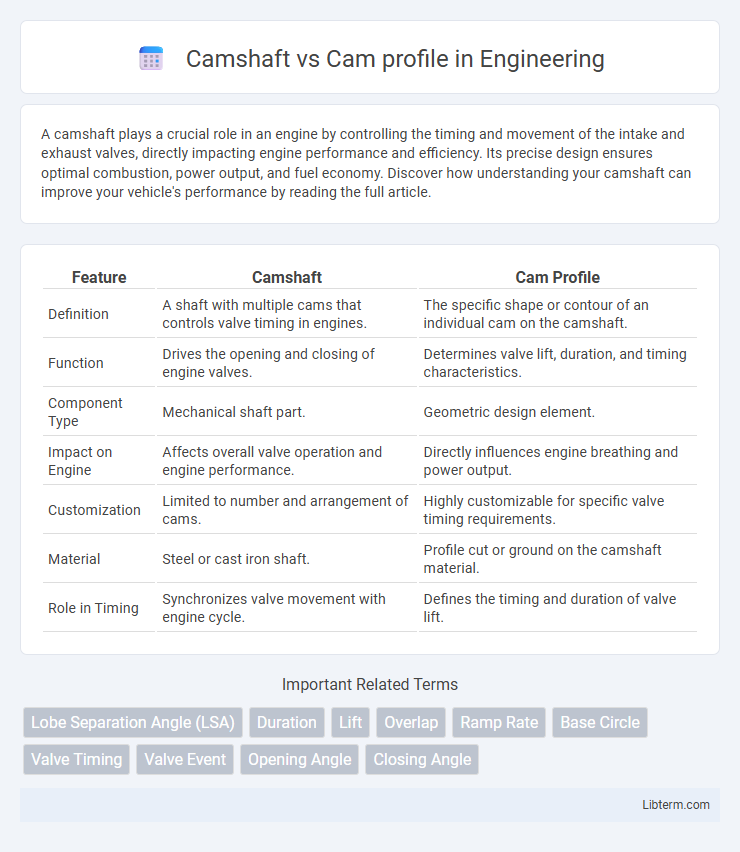A camshaft plays a crucial role in an engine by controlling the timing and movement of the intake and exhaust valves, directly impacting engine performance and efficiency. Its precise design ensures optimal combustion, power output, and fuel economy. Discover how understanding your camshaft can improve your vehicle's performance by reading the full article.
Table of Comparison
| Feature | Camshaft | Cam Profile |
|---|---|---|
| Definition | A shaft with multiple cams that controls valve timing in engines. | The specific shape or contour of an individual cam on the camshaft. |
| Function | Drives the opening and closing of engine valves. | Determines valve lift, duration, and timing characteristics. |
| Component Type | Mechanical shaft part. | Geometric design element. |
| Impact on Engine | Affects overall valve operation and engine performance. | Directly influences engine breathing and power output. |
| Customization | Limited to number and arrangement of cams. | Highly customizable for specific valve timing requirements. |
| Material | Steel or cast iron shaft. | Profile cut or ground on the camshaft material. |
| Role in Timing | Synchronizes valve movement with engine cycle. | Defines the timing and duration of valve lift. |
Introduction to Camshaft and Cam Profile
A camshaft is a crucial engine component responsible for controlling the timing and movement of the intake and exhaust valves through its rotating lobes. The cam profile refers to the specific shape and contour of these lobes, which directly influence valve lift, duration, and timing. Understanding the differences between camshaft and cam profile is essential for optimizing engine performance and efficiency.
What is a Camshaft?
A camshaft is a rotating cylindrical shaft in an internal combustion engine that controls the timing and movement of the intake and exhaust valves via cam lobes. Each cam lobe on the camshaft is precisely shaped to press against the valve lifters, converting rotational motion into linear motion to open and close the valves at specific intervals. Proper camshaft design is crucial for engine performance, affecting power output, fuel efficiency, and emissions.
Understanding Cam Profiles
Cam profiles determine the precise shape and contour of the cam lobes, which directly influence valve timing, lift, and duration in an internal combustion engine. Understanding cam profiles involves analyzing parameters like ramp shapes, base circle, and peak lift to optimize engine performance and efficiency. Camshafts serve as the rotating shaft housing these cam profiles, translating their design into mechanical motion to control valve operation.
Key Differences: Camshaft vs Cam Profile
The camshaft is a rotating shaft equipped with multiple cams that control the timing and movement of engine valves, directly influencing performance and efficiency. The cam profile refers to the specific shape of each cam's lobe, determining valve lift, duration, and timing characteristics, which affect engine power output and fuel consumption. While the camshaft functions as a mechanical component driving valve operation, the cam profile dictates the precise motion and dynamic behavior of the valves during the engine cycle.
How Camshaft Design Affects Engine Performance
Camshaft design critically influences engine performance by controlling valve timing, duration, and lift, which affect air-fuel mixture intake and exhaust gas expulsion. A cam profile with aggressive lift and longer duration enhances high-RPM power by allowing more airflow, while a milder profile improves low-end torque and fuel efficiency. Optimizing camshaft characteristics ensures balanced engine responsiveness, power output, and emission control.
The Role of Cam Profile in Valve Timing
The cam profile directly influences valve timing by controlling the lift, duration, and timing of valve opening and closing events in an internal combustion engine. Optimizing the cam profile enhances engine performance, fuel efficiency, and emissions by precisely coordinating the intake and exhaust valve operations. Precise camshaft design with tailored cam profiles ensures optimal airflow dynamics, improving combustion efficiency and power output.
Types of Camshafts and Their Applications
Camshafts vary primarily by design types such as flat-tappet, roller, and overhead camshafts, each tailored to specific engine demands and performance characteristics. Flat-tappet camshafts are commonly used in older engines due to their simplicity and cost-effectiveness, while roller camshafts offer enhanced durability and reduced friction, making them ideal for high-performance and racing applications. Overhead camshafts (including Single Overhead Camshaft - SOHC and Dual Overhead Camshaft - DOHC designs) provide improved valve timing precision and higher RPM capabilities, widely applied in modern passenger vehicles and motorsport engines for optimized power and efficiency.
Common Cam Profiles and Their Characteristics
Common cam profiles include the flat tappet, roller, and mushroom types, each designed to optimize valve timing and engine performance. Flat tappet cams offer simplicity and durability, roller cams reduce friction for higher RPM efficiency, and mushroom cams provide smooth valve operation with minimal noise. These profiles significantly influence engine power, fuel efficiency, and emission levels through precise control of valve lift, duration, and timing.
Choosing the Right Camshaft and Cam Profile
Choosing the right camshaft and cam profile directly impacts engine performance, fuel efficiency, and emissions. The camshaft controls valve timing, while the cam profile dictates valve lift and duration, both crucial for matching engine characteristics to desired power output. Optimizing the camshaft and cam profile selection ensures balanced torque, improved acceleration, and smoother idling tailored to specific driving conditions.
Conclusion: Optimizing Performance with the Right Combination
Selecting the optimal camshaft and cam profile combination significantly enhances engine performance by precisely controlling valve timing, lift, and duration. A well-matched cam profile tailored to the camshaft's design maximizes airflow, fuel efficiency, and power output for specific engine requirements. Prioritizing this synergy ensures improved torque curves, higher RPM capabilities, and overall better mechanical efficiency.
Camshaft Infographic

 libterm.com
libterm.com